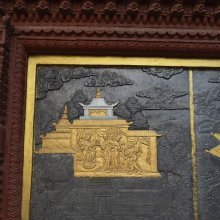Emptiness: 2 definitions
Introduction:
Emptiness means something in Buddhism, Pali, Hinduism, Sanskrit. If you want to know the exact meaning, history, etymology or English translation of this term then check out the descriptions on this page. Add your comment or reference to a book if you want to contribute to this summary article.
Images (photo gallery)
In Hinduism
Yoga (school of philosophy)
Source: ORA: Amanaska (king of all yogas): A Critical Edition and Annotated Translation by Jason BirchThe Emptiness (of all states) is denoted by the Sanskrit term Śūnya, according to the Amanaska Yoga treatise dealing with meditation, absorption, yogic powers and liberation.—Accordingly, as Īśvara says to Vāmadeva: “[...] [The Yogin] who has [attained] the natural [no-mind state] is instantly motionless as a result of having realized the emptiness of all states (akhilabhāva-śūnya), resides in his own self, his hands, feet and sense organs are all inactive and relaxed, and he is free of disturbances. Because he is one in whom breathing has radically ceased, he is seen by those standing close [to be] like an inanimate piece of wood and like the [steady flame of] a lamp situated in a windless [place]. [...]”.

Yoga is originally considered a branch of Hindu philosophy (astika), but both ancient and modern Yoga combine the physical, mental and spiritual. Yoga teaches various physical techniques also known as āsanas (postures), used for various purposes (eg., meditation, contemplation, relaxation).
In Buddhism
Tibetan Buddhism (Vajrayana or tantric Buddhism)
Source: OSU Press: Cakrasamvara SamadhiEmptiness (in Sanskrit: Śūnyatā) refers to the primary teaching of the Prajñāpāramitā ("The Perfection of Wisdom") of Mahāyāna Buddhism.—The doctrine of "emptiness" (śūnyatā) is based upon the doctrines of no-self and dependent origination. The doctrine of emptiness states that no thing exists independently in and of itself, there is no independent subject or object, and all things are interconnected, making up a universal oneness. Even the idea of emptiness as an independent concept cannot exist within emptiness, which excludes any extreme nihilistic interpretations of nothingness, still allowing for relative subjects and objects to exist within the universal oneness. Relative subjects and objects allow us to make sense of reality, with our limited faculties, the five aggregates. However, once we experience a realization of emptiness, we understand that our perception of reality as separate subjects and objects is not real. One can say to oneself, "I am that", and let go of the habitual need to grasp and cling to things, and overcome the suffering of separateness, while at the same time still be able to operate within the perceived reality of a world with relative subjects and objects.
Emptiness is the primary doctrine of Nāgārjuna, who founded the Mādhyamika school, which means "The Middle Way", which teaches that the nature of reality is not governed by extremes, either or solutions, or binary absolutes, but rather by an infinite spectrum of possibilities in between, which can only be discerned through discriminating wisdom, (prajñā).

Tibetan Buddhism includes schools such as Nyingma, Kadampa, Kagyu and Gelug. Their primary canon of literature is divided in two broad categories: The Kangyur, which consists of Buddha’s words, and the Tengyur, which includes commentaries from various sources. Esotericism and tantra techniques (vajrayāna) are collected indepently.
See also (Relevant definitions)
Full-text (+498): Shunyata, Shunyatashunyata, Atyantashunyata, Anavakarashunyata, Asamskritashunyata, Samskritashunyata, Bahirdhashunyata, Svabhavashunyata, Abhavashunyata, Adhyatmabahirdhashunyata, Adhyatmashunyata, Paramarthashunyata, Anavaragrashunyata, Mahashunyata, Sarvadharmashunyata, Shodashashunyata, Ghanaghanaghanta, Bhanabhanita, Anupalambha, Bhavashunya.
Relevant text
Search found 140 books and stories containing Emptiness; (plurals include: Emptinesses). You can also click to the full overview containing English textual excerpts. Below are direct links for the most relevant articles:
Maha Prajnaparamita Sastra (by Gelongma Karma Migme Chödrön)
IV. The emptinesses (śūnyatā) in the great Prajñāpāramitā-sūtras < [Note on emptiness (śūnyatā)]
Emptiness 4: Emptiness of Emptiness (śūnyatāśūnyatā) < [Chapter XLVIII - The Eighteen Emptinesses]
Emptinesses 16 to 18 < [Chapter XLVIII - The Eighteen Emptinesses]
Garga Samhita (English) (by Danavir Goswami)
Verse 6.14.26 < [Chapter 14 - The Glories of Ratnākara, Raivata, and Kācala]
Guhyagarbha Tantra (with Commentary) (by Gyurme Dorje)
Text 15.17 (Commentary) < [Chapter 15 (Text and Commentary)]
Text 4.7 (Commentary) < [Chapter 4 (text and commentary)]
Text 13.9 (Commentary) < [Chapter 13 (Text and Commentary)]
The Great Chariot (by Longchenpa)
Part 1 - How to train in the middle way free from extremes < [D. Abandoning]
Part 10b.6) The six perfections: Prajña that realizes the natural state < [B. the extensive explanation of arousing bodhicitta]
Part 2a - By knowing or not knowing what we are < [B. The extended explanation of the particulars]
Bodhisattvacharyavatara (by Andreas Kretschmar)
Text Section 141 < [Khenpo Chöga’s Oral Explanations]
Text Section 209 < [Khenpo Chöga’s Oral Explanations]
Text Sections 144-145 < [Khenpo Chöga’s Oral Explanations]
Things as They Are (by Acariya Maha Boowa Nanasampanno)
